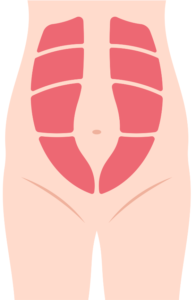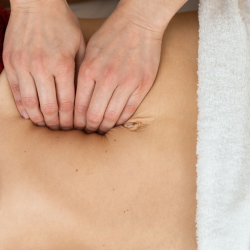Opinions about prenatal exercise and diastasis are often accepted as fact, including avoiding crunches and the prone position or abstaining from core exercises during pregnancy and postpartum. Unfortunately, many common recommendations for addressing diastasis are based on grains of truth or best guesses and are not consistent with recent research.
Diastasis is very common in pregnancy. However, safe, modified core exercises can decrease the risk of diastasis, while abstaining from ab exercises may lead to muscle atrophy and weakened core muscles.
Recent research has shown that gentle core exercises performed consistently during and soon after pregnancy, including abdominal planks, bracing, and curl-ups, can decrease abdominal separation and should not be avoided, as previously thought. More research is needed to understand the best methods. However, preventing diastasis through physical activity, weight management, and core strength is a safe and effective strategy.
This article provides a brief overview of the common misconceptions, a synthesis of recent studies, and recommendations to avoid diastasis.
WHAT IS DIASTASIS RECTI?
Diastasis recti, commonly shortened to diastasis, is the separation of the rectus abdominis down the linea alba. Though it can also occur in men who carry excess abdominal fat, the condition is most commonly associated with women during and after pregnancy due to hormonal shifts and the continual stress placed on the core from carrying a baby to term.
RECENT RESEARCH ON DIASTASIS RECTI AND CRUNCHES

The typical assessment for diastasis is performing a slight abdominal crunch while palpating with two fingers above and below the belly button to feel for a separation of the abdominal wall. A one-finger width or smaller is normal, but anything larger than two fingertips is considered diastasis.
Instead of crunches, women are sometimes encouraged to “draw in” their navel to their lower back during exercise and “suck in” their belly. As with many recommendations, there is a bit of truth to these ideas. Excessive intra-abdominal pressure should be avoided, and the core muscles should stay engaged during physical activity. However, avoiding exercises that specifically target the core is a mistake.
Studies have shown that the generalized advice women frequently receive, without detailed guidance, can do more harm than good. Crunches, or curl-ups as they are called in scientific literature, are safe and effective for strengthening the core when performed correctly (Schoenfeld & Kolber, 2016). They also typically do not need to be avoided during pregnancy or postpartum, as commonly suggested.
Simply drawing in the belly toward the spine can increase pressure down the midline of the abdominals widening the inter-recti distance, also called “the gap.” (Mota et al., 2015). Recent studies concluded that the common drawing in maneuver adds to the strain on the linea alba, resulting in an increased gap, while the curl-up closes the gap. Research has shown that crunches and other common core exercises can prevent and treat diastasis.

While it would be nice to end there, the human body is complex, so issues like diastasis recti are rarely black and white. Even though crunches have been proven effective in strengthening the core and closing the gap, a study using ultrasound technology showed that they might also distort the linea alba in people with diastasis. However, when performed after engaging the transversus abdominis, the distortion was reduced or eliminated (Lee & Hodges, 2016).
This finding reinforces the idea that crunches are not inherently good or bad, but like most exercises, they must be taught and performed correctly to reap the benefits. Unfortunately, many expectant and new mothers unnecessarily cease all core exercises to prevent diastasis because of the confusion and controversy surrounding the topic rather than making the necessary subtle adjustments. Although, preventing diastasis is easier than attempting to fix it.
Allowing core muscles to atrophy for nine months (followed by several months postpartum) increases the chances of muscles separating under the strain of pregnancy and delivery. The conflicting advice does women a disservice.
Science is conclusive that the safest and most effective strategy for preventing diastasis is with consistent physical activity, weight management, and core strengthening exercises (including crunches) throughout a healthy pregnancy and postpartum.
EXERCISE TIPS FOR DIASTASIS PREVENTION
Since women are typically advised not to exercise flat on a hard surface after the first trimester, gentle crunches on a stability ball or a slightly inclined bench are convenient alternatives to the mat.
Core strength can also be accomplished by performing deep breathing exercises, pelvic tilts, planks, modified push-ups, and other bodyweight exercises that engage the abdominals. It is important to avoid deep twisting through the midsection and quick twisting movements like bicycle crunches that add additional stress to the already stretched abdominal wall during and soon after pregnancy.
Proper breathing is critical for keeping the core strong and avoiding excess strain. Holding the breath and bearing down, called the Valsalva maneuver, is commonly associated with crunches, heavy lifting, and other strenuous exercises. It creates excess intra-abdominal pressure, which can cause serious problems with the core and pelvic floor. Exhaling on the exertion of any movement can alleviate internal pressure. This is also a helpful practice for preparing for the breathing and physical exertion of labor.
Each exercise should begin with proper alignment to consistently reinforce good posture, promote hip stability, and correct muscle imbalances. Avoiding excessive anterior pelvic tilt or “sway back” will lessen the strain on the abdominal wall and lower back. Mothers returning to exercise after giving birth should ease back into training, focusing on restoring neutral alignment and rehabilitating the core and pelvic floor rather than weight loss or intensity. Studies have shown that exercise, including curl-ups with an activated transverse abdominis, can help close the gap and increase core strength.
Severe cases of diastasis can be a challenge, so encouraging pregnant women and new moms to prevent diastasis by maintaining a strong core and dispelling myths about prenatal and postnatal exercise is essential.
The following exercises can help to maintain a strong core during pregnancy and postpartum. Click the links below for a brief demo:
Pelvic Tilt with Crunch on Ball
Opposite Arm and Leg Extension
REFERENCES:
Hakan, K. (2018). Umbilical Hernia Repair and Pregnancy: Before, during, after…. Frontiers in Surgery, 5(1).
Lee, D. & Hodges P. (2016). Behavior of the linea alba during a curl-up task in diastasis rectus abdominis: An observational study. Journal of Orthopaedic & Sports Physical Therapy, 46(7), 580-589.
Mota, P., Pascoal, A., Carita, A. & Bø, K. (2015). Inter-recti distance at rest, during abdominal crunch and drawing in exercises during pregnancy and postpartum. Physiotherapy, 101.
Schoenfeld, B. & Kolber, M. (2016). Abdominal Crunches Are/Are Not a Safe and Effective Exercise. Strength and Conditioning Journal, 38(1), 61-62.